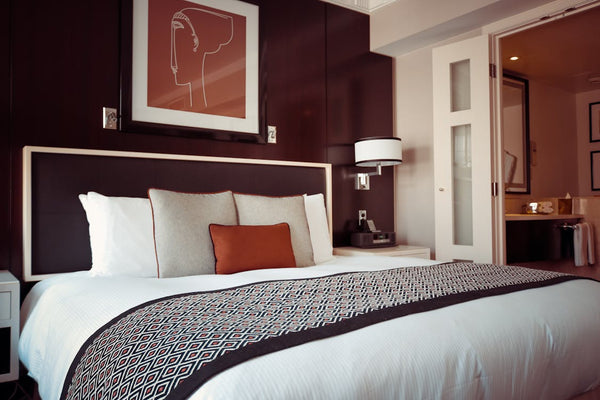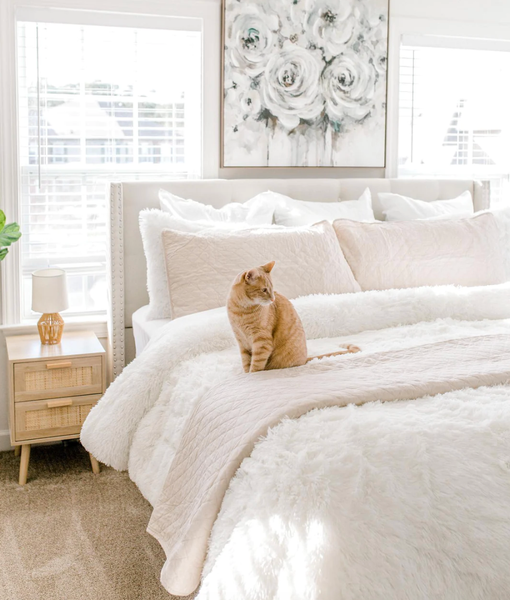Guest Blog:
6 Color Coordination Tips from Expert House Painters for a New Bedroom Look
Renovating your bedroom is an exciting endeavor, presenting an opportunity to craft a haven that mirrors your individuality and taste. Among the essential elements of bedroom redesign, color coordination reigns supreme. Your chosen colors establish the atmosphere of the room, shaping mood, ambiance, and aesthetic allure.
Whether you seek a tranquil sanctuary or an energizing escape, mastering the art of color coordination is fundamental. Here are some expert insights to assist you along the way.

#1 Start with a Base Color
A strong foundation sets the stage for a well-executed bedroom design.
Start by selecting a base color to serve as the primary backdrop. Popular choices include soft gray undertones, creamy whites, or warm beige, creating a serene atmosphere.
According to Better Homes & Gardens, these neutral colors or tones offer a versatile canvas that complements nearly any accent color. You can later add tones of navy blue or brown to give the interior a rustic look. While such combinations using neutral colors are more suited for a living room, there’s no reason why you can’t have them in a bedroom.
#2 Incorporate Accent Colors
Once you've established your base color, it's time to infuse personality and character into your bedroom with accent colors. According to StudioBinder, accent colors add depth, interest, and visual contrast. This works particularly well for a rather neutral palette. That, in turn, helps make the space more dynamic and engaging.
Choose two or three complementary or contrasting hues that resonate with your style and preferences. For example, if your base color is a soft gray, you might introduce accents of blush pink and metallic gold for a sophisticated touch.
#3 Consider the 60-30-10 Rule
A tried-and-true method for achieving a well-balanced color scheme is the 60-30-10 rule. This guideline suggests allocating 60 percent of the room to the dominant color. Then, allocate 30 percent to the secondary color and 10 percent to the accent color. Following this rule ensures a cohesive look while allowing for enough variation to prevent monotony.
For instance, if your base color is a calming blue, you might use it for 60 percent of the room. Then, introduce a secondary color like crisp white for 30 percent of the space. After that, incorporate pops of a vibrant accent color such as citrus yellow for the remaining 10 percent.
#4 Create Visual Flow with a Color Scheme
Harmonizing your color palette creates a sense of unity and cohesion throughout the bedroom. Choose a color scheme that reflects your desired mood and style, whether it's monochromatic, analogous, complementary, or triadic.
As per a house paint color recommendation from ALEX Painting, experiment with different color schemes to find which one resonates with your aesthetic vision. A monochromatic scheme, for example, uses varying shades of a single color for a subtle and sophisticated look. An analogous scheme, on the other hand, combines colors adjacent to each other on the color wheel for a harmonious and cohesive feel.
#5 Layer Textures for Dimension
Color coordination goes beyond just paint and textiles. It extends to the textures and finishes within your bedroom.
Incorporating a variety of textures adds depth and dimension to the space, enhancing visual interest and tactile appeal. Mix and match textures like plush velvet, smooth satin, rustic wood, and sleek metal to create a multi-dimensional environment that feels rich and inviting. Consider how different textures interact with light and shadow, as this can further enhance the overall ambiance of the room.
#6 Don't Forget About Lighting
Proper lighting is essential for showcasing your carefully curated color scheme and setting the mood in your bedroom. Natural light, artificial lighting, and accent lighting all play a crucial role in highlighting colors and creating ambiance.
Optimize the influx of natural light by selecting sheer curtains or blinds, facilitating the gentle passage of sunlight into the room. Apart from enhancing the aesthetics of your bedroom, natural light is also vital for your mental health.
According to Queensland Health, natural light alleviates symptoms of depression in individuals with seasonal affective disorder (SAD). Additionally, exposure to natural light can boost serotonin levels, a neurotransmitter regulating mood and happiness, while simultaneously mitigating symptoms of depression and anxiety.
Enhance the natural illumination with a combination of layered artificial lighting, incorporating overhead fixtures, task-specific lighting, and ornamental lamps. Also, consider the color temperature of your light sources, opting for warm tones to enhance cozy spaces and cool tones for a refreshing atmosphere.
Frequently Asked Questions (FAQs)
What is the correct way to color coordinate?
Utilize the rainbow spectrum (ROYGBIV) for color coordination – white, tan, pink, red, orange, yellow, green, blue, indigo, violet, brown, gray, and black. For patterned items with various colors, establish a designated "patterned section" or identify its primary color and categorize it accordingly.
What are the luckiest bedroom colors?
Shades of green, blue, pink, and purple are considered the most auspicious colors for bedrooms, thought to foster tranquility and calmness within this space. Furthermore, white is highly recommended for bedrooms due to its association with enhancing clarity of thought.
What is the best color for bedroom interior in 2024?
In 2024, designers are favoring seven key hues for bedrooms, including pale green, new neutrals, sage green, midnight blue, red, forest green, and yellow. These colors reflect current trends in bedroom design and décor.
In conclusion, color coordination is a powerful tool for transforming your bedroom into a stylish and harmonious retreat. By following these tips, you can create a space that reflects your personality, evokes the desired mood, and leaves a lasting impression.
Whether you prefer serene neutrals or vibrant hues, mastering color coordination will elevate your bedroom design to new heights of sophistication and style.
About The Author:
|
|
Nikki has about 15 years experience in digital marketing, health and business writing. Connecting to people, travelling and sharing thoughts are something she would love to do. |








Leave a comment